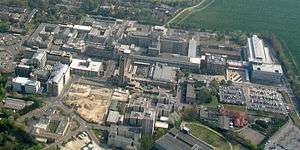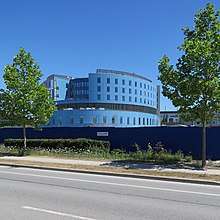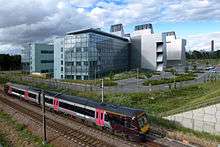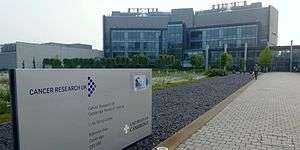Cambridge Biomedical Campus
The Cambridge Biomedical Campus is the largest centre of medical research and health science in Europe.[1][2] The site is located at the southern end of Hills Road in Cambridge, England. Over 20,000 people work at the site and is home to a number of organisations including: Cambridge University Hospitals NHS Foundation Trust, Royal Papworth Hospital NHS Foundation Trust, Abcam, the Wellcome Trust, Cancer Research UK, the university's medical school,[3] the UK government's Medical Research Council and has National Institute for Health Research Biomedical Research Centre status. It is an accredited UK academic health science centre (Cambridge University Health Partners).
 Aerial view of part of the Cambridge Biomedical Campus | |
| Affiliation | |
|---|---|
| Location | , |
| Website | cambridge-biomedical |
Constituent institutes
The Cambridge Biomedical Campus is home to the following institutes.[4]
Addenbrooke's Hospital
Addenbrooke's Hospital is a large teaching hospital, and the central focus of the campus.
New Royal Papworth Hospital

Papworth Hospital moved to new premises on the Cambridge Biomedical Campus in Spring 2019.[5][6]
AstraZeneca
AstraZeneca's global research and development facility is due to be based on the campus[7] and will house a workforce of approximately 2,000 individuals. It will be home to both early and late-stage medicines discovery and development, and cover both small molecules and biologics. Research activities will span all preclinical functional groups, including antibody engineering, medicinal chemistry and high throughput screening.
University of Cambridge School of Clinical Medicine
The University of Cambridge Medical School, established in 1976.
MRC Laboratory of Molecular Biology

The LMB is a molecular biology research institute funded by the UK Medical Research Council. It was founded in Cambridge in 1947 as the Unit for Research on the Molecular Structure of Biological Systems and moved to a site adjacent to Addenbrooke's Hospital in 1962. A 27,000m2 replacement building close to the previous site was completed in 2012 and opened in May 2013.[8]
The laboratory has won nine Nobel Prizes including the 1962 prize (Physiology or Medicine) awarded for the discovery of the double-helix structure of DNA.[9]
Wellcome Trust - Medical Research Council Cambridge Stem Cell Institute
The Wellcome Trust-Medical Research Council Cambridge Stem Cell Institute or 'SCI' is a virtual organisation composed of the Anne McLaren Laboratory for Stem Cell Biology and Regenerative Medicine and the Wellcome Trust Centre for Stem Cell Research, as well as University-based Principal Investigators working in neighbouring Cambridge institutes whose research is primarily focused on stem cell biology and/or translation. The SCI is principally funded by the Wellcome Trust and the Medical Research Council. The Wellcome Trust also funds the SCI's internationally competitive 4-Year PhD Programme in Stem Cell Biology and Medicine. Stem cell biology and regenerative medicine research is a designated University of Cambridge Strategic Initiative.
The aims of the SCI are:
- To make fundamental discoveries that provide new insights into stem cell function and potency;
- To understand the role of stem and progenitor cells in disease and thereby to improve diagnosis and treatment;
- To harness the capacity of endogenous stem and progenitor cells for repair and regeneration;
- To exploit stem cells as tools for studying the molecular pathogenesis of human diseases and discovery of therapeutic agents;
- To nurture future generations of stem cell scientists and clinical investigators in an intellectually invigorating mix of basic and translational research.
The SCI was formed in 2012 following an £8m investment by the Wellcome Trust and the Medical Research Council.[10] The SCI will eventually be housed in a purpose-built 8000m2 facility to be constructed on the Cambridge Biomedical Campus site.
Cancer Research UK Cambridge Institute

The Cancer Research UK Cambridge Institute is one of four core funded Cancer Research UK Institutes [11] and a department of the University of Cambridge. In 2018, the department received an annual budget of £45 million, £27.8 million of which came from Cancer Research UK. The Institute offers highly competitive PhD programmes; both studentships and clinical research training fellowships (for aspiring clinical academics), attracting applicants from the UK and around the world. Cancer research is a designated University of Cambridge Strategic Initiative.
Research in the Institute focuses primarily on Tumour Ecology and Evolution, with investigations across four main areas:[12]
- Basic research, which involves looking into the cellular and molecular biology of cancer.
- Research into molecular imaging, genomics, bioinformatics and biomolecular modeling.
- Research that focuses on specific cancer sites, forming a bridge between the clinical and laboratory areas.
- Clinical investigations and trials, including population based studies into screening and prevention.
The centre was officially opened by Queen Elizabeth II in February 2007. In 2018, Professor Gregory Hannon was announced as the new Director, taking over from Professor Simon Tavaré.[13]
Senior Group Leader at the Institute, Professor Richard Gilbertson, is the Director of the Cancer Research UK Cambridge Centre, a network that encourages local collaborations between universities, NHS hospitals, and other research organisations.[14]
Cambridge Institute for Medical Research
The CIMR is a cross-departmental institute in the University of Cambridge, receiving funding from the Wellcome Trust. Research is focused on four main areas: misfolded proteins and disease, intracellular membrane traffic, autoimmune disease and haematopoietic stem cell biology.[15]
Wolfson Brain Imaging Centre
The Wolfson Brain Imaging Centre was created in 1995 to develop and apply advanced imaging methods to patients with traumatic brain injury. It is unique in being co-located with the Neurosciences Critical Care Unit of Addenbrooke's Hospital. Since its establishment it has become an internationally leading Positron Emission Tomography and Magnetic Resonance Imaging centre.
Hutchison/MRC Research Centre
The Hutchison/MRC Research Centre is a cancer research centre housing researchers from the University of Cambridge Department of Oncology, the MRC Cancer Cell Unit, and the University of Cambridge "Cambridge Molecular Therapeutics Programme".[16] It was built in 2001 with funding from the Medical Research Council and a donation to the University of Cambridge from Hutchison Whampoa Ltd. The Hutchison/MRC Research Centre is a member institute of the Cambridge Cancer Centre, a virtual organisation of Cambridge researchers whose work has current or potential application to cancer research.
Rosie Maternity Hospital
The Rosie Hospital is Cambridge's first purpose-built maternity hospital, opened in October 1983. A multimillion-pound extension of the Rosie Hospital was completed in 2012.
MRC Mitochondrial Biology Unit
The MRC Mitochondrial Biology Unit is a department of the School of Clinical Medicine of the University of Cambridge, funded by the Medical Research Council. It is focused on research to understand mitochondrial process and their involvement in human diseases.[17] It is co-located with the Cambridge Institute for Medical Research in the Wellcome Trust/MRC Building.
Institute of Metabolic Science
The Institute of Metabolic Science (IMS) is dedicated to research, education, prevention and clinical care in the areas of diabetes, obesity and related metabolic and endocrine diseases.[18] The Institute is a joint venture between the University of Cambridge, The Medical Research Council, Cambridge University NHS Hospitals Trust and the Wellcome Trust.[19] It is led by Co-Directors Professor Sir Stephen O'Rahilly and Professor Nick Wareham.
Brain Repair Centre
Adjacent to the Institute of Public Health, Cambridge Centre for Brain Repair is a subsidiary of the University of Cambridge Department of Clinical Neurosciences. It is a research institute aiming to "understand, and eventually to alleviate and repair damage to the brain and spinal cord which results from injury or neurodegenerative disease."[20]
Institute for Public Health
The Institute for Public Health is a partnership between the University of Cambridge, the Medical Research Council and the National Health Service. It was created in 1993 to study disease in the population and to identify, evaluate and monitor public healthcare interventions.[21]
University Technical College Cambridge
The University Technical College Cambridge is a new secondary school for 14- to 18-year-olds offering GCSE, B-Tech and A-Level courses. It opened on 8 September 2014 in the Deakin Centre. On Friday 19 September 2017, it moved into its own building on Robinson Way, situated next to the Long Road Sixth Form College, parallel to the Bio-Medical Campus which encompasses Addenbrooke's Hospital, rebranded as Cambridge Academy for Science and Technology.
Other
Other entities located on the Cambridge Biomedical Campus include:
- Institute for Diabetes, Endocrinology and Metabolism
- GlaxoSmithKline Clinical Research Unit
- MRC Centre for Protein Engineering
- National Blood Service
- Strangeways Research Laboratory
References
- AstraZeneca selects location for new global R&D centre and corporate headquarters in Cambridge, UK, AstraZeneca Press Release 2013-06-18
- "Archived copy". Archived from the original on 28 September 2013. Retrieved 28 September 2013.CS1 maint: archived copy as title (link)
- Watson-Capps, J. J.; Cech, T. R. (2014). "Academia and industry: Companies on campus". Nature. 514 (7522): 297. doi:10.1038/514297a.
- "Cambridge Biomedical Campus". Archived from the original on 8 July 2011. Retrieved 14 September 2010.
- "Papworth Hospital building work set to start at Addenbrooke's site - BBC News". Bbc.co.uk. Retrieved 1 October 2018.
- "Papworth buys land ready for Cambridge move - BBC News". Bbc.co.uk. Retrieved 1 October 2018.
- AstraZeneca announces new Cambridge Biomedical Campus HQ, BBC News 2013-06-18
- "Her Majesty the Queen opens the new MRC Laboratory of Molecular Biology". Cambridge University. 23 May 2013. Retrieved 1 July 2013.
- The History of the Laboratory of Molecular Biology (LMB), University of Cambridge
- Wellcome Trust and MRC invest in world-class Stem Cell Institute, Wellcome Trust Press release 2012-08-09
- "Cancer Research UK Institutes". Archived from the original on 29 January 2010. Retrieved 14 September 2010.
- "The Institute". Cancer Research UK Cambridge Institute. Retrieved 6 December 2018.
- "New Director of Cancer Research UK Cambridge Institute announced". University of Cambridge. 16 November 2017. Retrieved 6 December 2018.
- "Our Research Centres". Cancer Research UK. 11 March 2014. Retrieved 6 December 2018.
- Cambridge Institute for Medical Research (CIMR), University of Cambridge
- "Archived copy". Archived from the original on 2 August 2010. Retrieved 14 September 2010.CS1 maint: archived copy as title (link)
- "Introduction from the Director | MRC Mitochondrial Biology Unit". Mrc-mbu.cam.ac.uk. Retrieved 1 October 2018.
- Partners. "Home - Institute of Metabolic Science". Ims.cam.ac.uk. Retrieved 1 October 2018.
- "Home". Institute of Metabolic Science. Retrieved 6 December 2018.
- "Archived copy". Archived from the original on 13 October 2010. Retrieved 14 September 2010.CS1 maint: archived copy as title (link)
- "Archived copy". Archived from the original on 11 September 2010. Retrieved 14 September 2010.CS1 maint: archived copy as title (link)
